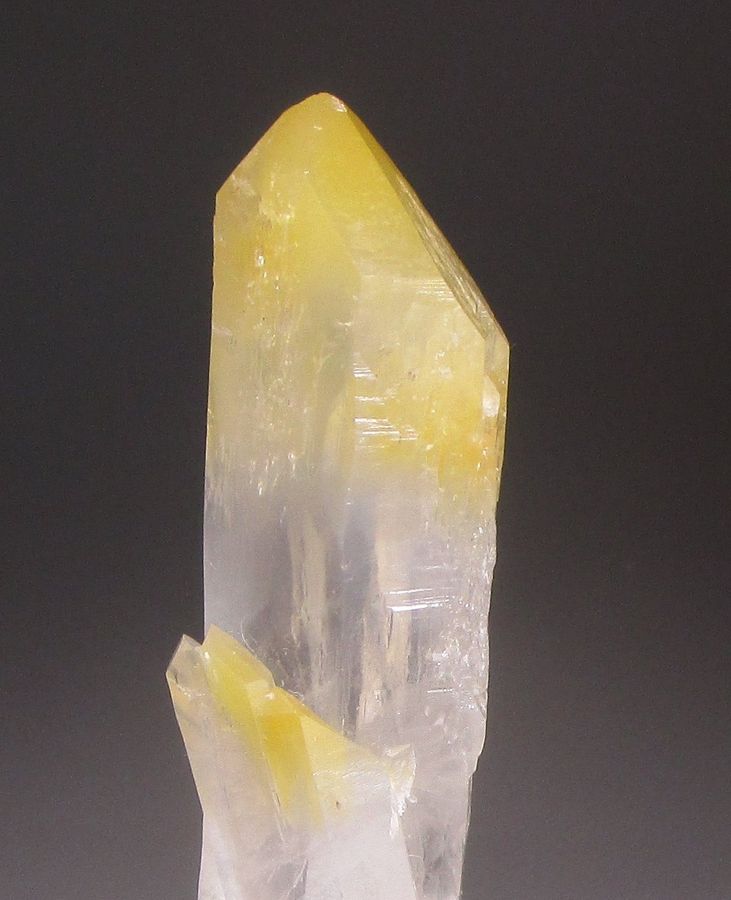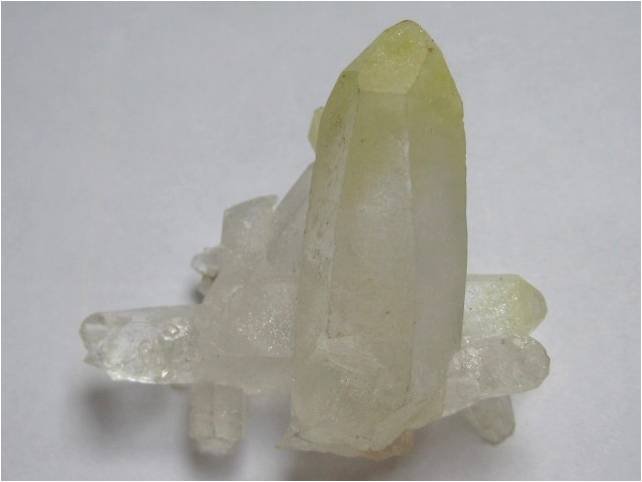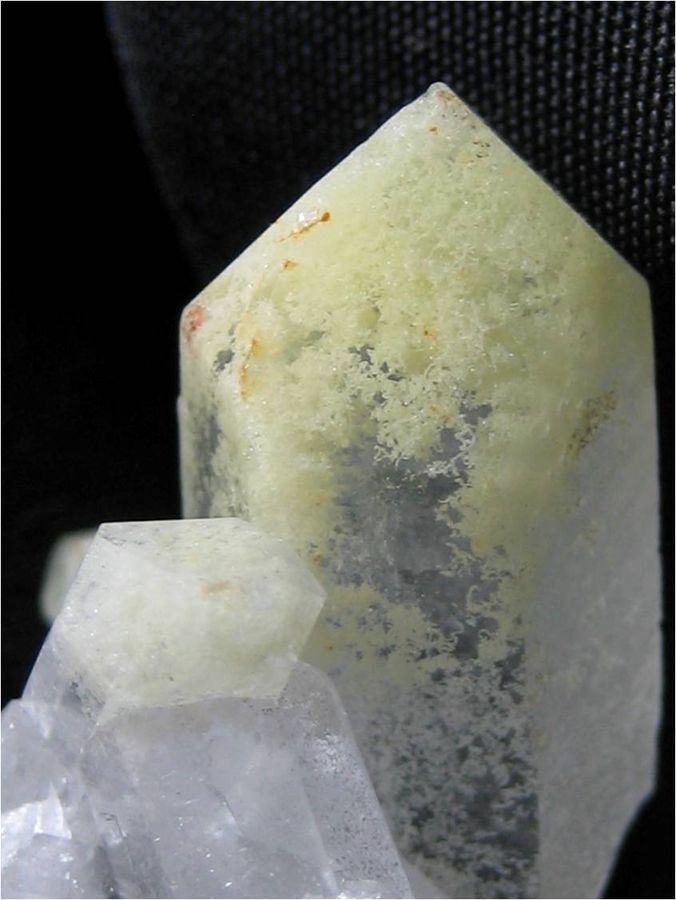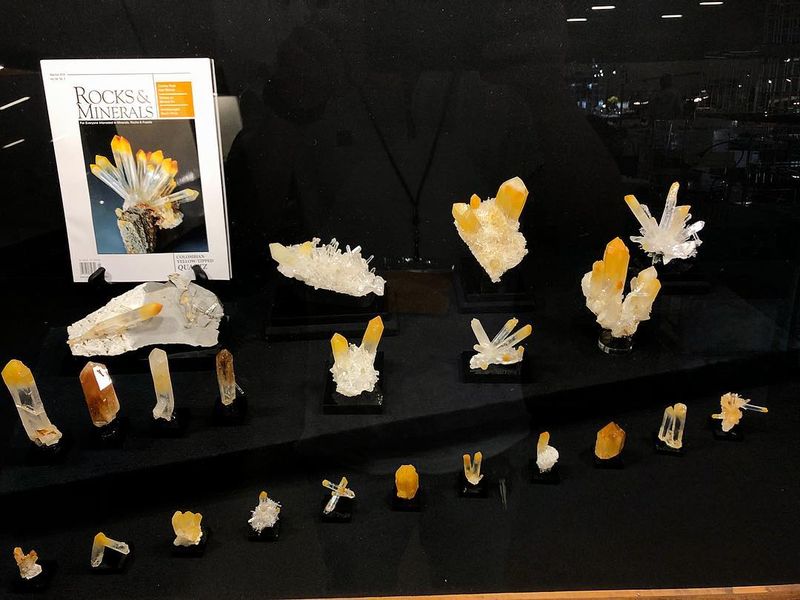| View previous topic :: View next topic |
| Author |
Message |
John Rakovan
Joined: 25 Mar 2014
Posts: 12
Location: Bureau of Geology and Mineral Resources, New Mexico Institute of Mining and Technology


|
 Posted: Oct 06, 2018 07:56 Post subject: Quartz and Humboldtine? from Colombia Posted: Oct 06, 2018 07:56 Post subject: Quartz and Humboldtine? from Colombia |
|
|
Colorless quartz crystals that are heavily included at their terminations with a vivid yellow material have recently appeared on the specimen market ( https://www.mindat.org/photo-875255.html ). We have been working to identify the yellow inclusions and first reported them to be humboldtine. We now believe that to be incorrect.
Early attempts to isolate yellow fibers from within the quartz or to identify them via Raman spectroscopy were unsuccessful.
One specimen in our possession had yellow fibrous material exposed at its surface. This was used for powder X-ray diffraction (PXRD) on a Bruker Quest (Mo K-alpha). The data give an excellent match with humboldtine.
Later, fibers from inside a quartz crystal were isolated. These give no discernable X-ray diffraction pattern. Multiple XRD datasets from included material reveal only quartz, which must be admixed with some of the fiber samples.
If the fibers are X-ray amorphous, this would explain why the first PXRD data shows only humboldtine. An admixture of humboldtine with an amorphous material will only yield diffraction peaks for humboldtine.
Another quartz sample exhibited a small area coated with a druse of tiny, sharp, equant, yellow crystals. PXRD data from these also match humboldtine.
We speculate that the surface humboldtine taken from the two samples described above is a product of cleaning with oxalic acid. Iron staining (iron oxides) on quartz can be effectively removed by soaking in Oxalic acid. This is a common practice in cleaning quartz specimens. Dissolved iron can then combine with oxalic acid C2H2O4 to form humboldtine Fe2+(C2O4) · 2H2O if the samples are not adequately rinsed.
Further study of the yellow fibrous inclusions is ongoing.
John Rakovan, Miami University
| Description: |
|
| Viewed: |
32872 Time(s) |

|
|
|
| Back to top |
|
 |
lluis
Joined: 17 Nov 2006
Posts: 719


|
 Posted: Oct 06, 2018 08:10 Post subject: Re: Quartz and Humboldtine? from Colombia Posted: Oct 06, 2018 08:10 Post subject: Re: Quartz and Humboldtine? from Colombia |
|
|
Hi, John
Thanks for all info!
Being chemist myself, and cleaning minerals, I think that what you say is just what happened: a badly cleaned iron stained quartz... (that is as many ones I have seen...)
With best wishes
Lluís
|
|
| Back to top |
|
 |
Bob Harman
Joined: 06 Nov 2015
Posts: 765



|
 Posted: Oct 06, 2018 10:41 Post subject: Re: Quartz and Humboldtine? from Colombia Posted: Oct 06, 2018 10:41 Post subject: Re: Quartz and Humboldtine? from Colombia |
|
|
| JOHN, As you know there were several of these examples in Denver. The best were VERY pricey. Are you saying there might be intentional partial cleaning of iron staining with an intention to deceive? BOB
|
|
| Back to top |
|
 |
alfredo
Site Admin

Joined: 30 Jan 2008
Posts: 1014



|
 Posted: Oct 06, 2018 11:46 Post subject: Re: Quartz and Humboldtine? from Colombia Posted: Oct 06, 2018 11:46 Post subject: Re: Quartz and Humboldtine? from Colombia |
|
|
There are undoubtedly more "minerals" around that were the accidental result of cleaning procedures, and some of them have even wangled their way through the IMA approval procedure and become "approved species".
A few years ago I noticed some tiny colorless tourmaline-like rods on fumarolic hematite from Argentina. The crystals turned out to be lead citrate, the result of attempts by local Argentines to remove ugly white anglesite crusts with citric acid, and these crystals only narrowly avoided getting submitted to the IMA as a potential new species, but they did at least result in an interesting journal paper (by Tony Kampf) because they were a new structure type.
|
|
| Back to top |
|
 |
John Rakovan
Joined: 25 Mar 2014
Posts: 12
Location: Bureau of Geology and Mineral Resources, New Mexico Institute of Mining and Technology


|
 Posted: Oct 06, 2018 14:24 Post subject: Re: Quartz and Humboldtine? from Colombia Posted: Oct 06, 2018 14:24 Post subject: Re: Quartz and Humboldtine? from Colombia |
|
|
| Bob Harman wrote: | | JOHN, As you know there were several of these examples in Denver. The best were VERY pricey. Are you saying there might be intentional partial cleaning of iron staining with an intention to deceive? BOB |
Hi Bob,
No, this is not at all what I am saying. I don’t think there has been any attempt to deceive. These are natural specimens. I have seen photos of them in situ.
The yellow fibrous inclusions which make the specimens so beautiful are all natural. In many cases they are completely encased in the quartz and could not be affected by cleaning. What I am saying is that our original identification of what the fibers are is incorrect. We do not yet know what they are. We do know that they are not humboldtine.
Cheers,
John
|
|
| Back to top |
|
 |
Bob Harman
Joined: 06 Nov 2015
Posts: 765



|
 Posted: Oct 06, 2018 14:36 Post subject: Re: Quartz and Humboldtine? from Colombia Posted: Oct 06, 2018 14:36 Post subject: Re: Quartz and Humboldtine? from Colombia |
|
|
| OKAY! That should adequately explain it to both Lluis and me. BOB
|
|
| Back to top |
|
 |
Fiebre Verde

Joined: 11 Sep 2013
Posts: 944
Location: Paris Area



|
 Posted: Oct 06, 2018 15:06 Post subject: Re: Quartz and Humboldtine? from Colombia Posted: Oct 06, 2018 15:06 Post subject: Re: Quartz and Humboldtine? from Colombia |
|
|
Then what is not natural is the Columbia part of the story.
Columbia is (sometimes) the fake word for Colombia.
(nothing personal John - this is a VERY interesting thread :-) )
Gérard
All fixed Gérard.
Michael
|
|
| Back to top |
|
 |
Jordi Fabre
Overall coordinator of the Forum

Joined: 07 Aug 2006
Posts: 5090
Location: Barcelona



|
 Posted: Oct 06, 2018 16:43 Post subject: Re: Quartz and Humboldtine? from Colombia Posted: Oct 06, 2018 16:43 Post subject: Re: Quartz and Humboldtine? from Colombia |
|
|
Thanks a lot John, very useful.
I'm taking off the word Humboldtine from all the "Mineral" boxes because they are "institutional" boxes and of course not from the FMFers' texts that should be always strongly respected.
|
|
| Back to top |
|
 |
marco campos-venuti

Joined: 09 Apr 2014
Posts: 234
Location: Sevilla



|
 Posted: Oct 07, 2018 12:20 Post subject: Re: Quartz and Humboldtine? from Colombia Posted: Oct 07, 2018 12:20 Post subject: Re: Quartz and Humboldtine? from Colombia |
|
|
I bought this in 2006, supposedly from Brazil. It looks so similar!
Here the yellow appears to be inside. The vermicular growth reminds me of chlorite family minerals. The yellow is brighter in real life than in the pictures. Is it a different thing?
| Mineral: | Quartz |
| Locality: | | Brazil |  |
|
| Dimensions: | 3 cm |
| Description: |
|
| Viewed: |
32530 Time(s) |

|
| Mineral: | Quartz |
| Locality: | | Brazil |  |
|
| Dimensions: | 3 cm |
| Description: |
|
| Viewed: |
32510 Time(s) |

|
|
|
| Back to top |
|
 |
John Rakovan
Joined: 25 Mar 2014
Posts: 12
Location: Bureau of Geology and Mineral Resources, New Mexico Institute of Mining and Technology


|
 Posted: Oct 12, 2018 09:42 Post subject: Re: Quartz and Humboldtine? from Colombia Posted: Oct 12, 2018 09:42 Post subject: Re: Quartz and Humboldtine? from Colombia |
|
|
Hi Marco,
The habit of the inclusions in the Columbian quartz is distinctly different. It does not look at all vermicular as do the inclusions in your sample.
Cheers,
John
| marco campos-venuti wrote: | I bought this in 2006, supposedly from Brazil. It looks so similar!
Here the yellow appears to be inside. The vermicular growth reminds me of chlorite family minerals. The yellow is brighter in real life than in the pictures. Is it a different thing? |
|
|
| Back to top |
|
 |
Bob Harman
Joined: 06 Nov 2015
Posts: 765



|
 Posted: May 12, 2019 01:08 Post subject: Re: Quartz and Humboldtine? from Colombia Posted: May 12, 2019 01:08 Post subject: Re: Quartz and Humboldtine? from Colombia |
|
|
The current issue of R & M periodical (vol 94 #3, May-June 2019) has an article by John Rakovan and David Ziga on these very interesting Colombian quartz specimens.
David Ziga had a wonderful display case devoted exclusively to these specimens at the recent Cincinnati mineral show. In fact, his case won an award at the show.
Unfortunately, I did not photograph his case; perhaps John R or another follower of this forum might have taken a picture of the case? It was quite an impressive display. BOB
|
|
| Back to top |
|
 |
John Rakovan
Joined: 25 Mar 2014
Posts: 12
Location: Bureau of Geology and Mineral Resources, New Mexico Institute of Mining and Technology


|
 Posted: May 12, 2019 06:50 Post subject: Re: Quartz and Humboldtine? from Colombia Posted: May 12, 2019 06:50 Post subject: Re: Quartz and Humboldtine? from Colombia |
|
|
Bob, here is a photo of the display at the 2019 Cincinnati Geofair
| Description: |
| Display at the 2019 Cincinnati Geofair |
|
| Viewed: |
30925 Time(s) |

|
|
|
| Back to top |
|
 |
Bob Harman
Joined: 06 Nov 2015
Posts: 765



|
 Posted: May 12, 2019 07:20 Post subject: Re: Quartz and Humboldtine? from Colombia Posted: May 12, 2019 07:20 Post subject: Re: Quartz and Humboldtine? from Colombia |
|
|
| PERFECT !! Regards and thanks John, BOB
|
|
| Back to top |
|
 |
Fiebre Verde

Joined: 11 Sep 2013
Posts: 944
Location: Paris Area



|
 Posted: May 12, 2019 09:40 Post subject: Re: Quartz and Humboldtine? from Colombia Posted: May 12, 2019 09:40 Post subject: Re: Quartz and Humboldtine? from Colombia |
|
|
| Bob Harman wrote: | The current issue of R & M periodical (vol 94 #3, May-June 2019) has an article by John Rakovan and David Ziga on these very interesting Colombian quartz specimens.
David Ziga had a wonderful display case devoted exclusively to these specimens at the recent Cincinnati mineral show. In fact, his case won an award at the show.
Unfortunately, I did not photograph his case; perhaps John R or another follower of this forum might have taken a picture of the case? It was quite an impressive display. BOB |
Hi Bob
I have no access to that R & M issue.
Does the article explain what’s causing the yellowish/brownish color?
Gerard
|
|
| Back to top |
|
 |
Bob Harman
Joined: 06 Nov 2015
Posts: 765



|
 Posted: May 12, 2019 11:37 Post subject: Re: Quartz and Humboldtine? from Colombia Posted: May 12, 2019 11:37 Post subject: Re: Quartz and Humboldtine? from Colombia |
|
|
Fiebre,
I am not a geologist so John R would be able to say more on this subject. Reread his original posting above on this subject.
However, from the article and what little I know, the answer is very complex and elusive. The yellowish color occurs mostly in fibers within the crystals rather than on the surface. Surface yellowish coloration, mostly due to iron oxides, has been ruled out, but its removal also posses a problem as when oxalic acid is used to remove the iron oxides, this seems to also affect the internal fibers in question, apparently forming humboldtine! . Humboldtine for the internal fibers was the early consideration, but is now suspected to be incorrect, except that testing after cleaning, repeatedly shows some alteration back to the humbodltine. The intimately admixed quartz fibers also interfere with testing, with various assays identifying only quartz.
All this is beyond me so other folks will have to add to this and explain more clearly. Bob
|
|
| Back to top |
|
 |
|





